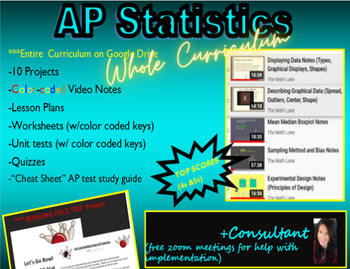AP Statistics/Stats FULL Curriculum LINK (notes, wksts, PROJECTS) and Consultant
- Word Document File
Description
Get ready to supercharge your students' AP Statistics experience with this dynamic curriculum! With over 50% of students earning 4s or 5s on the AP exam, this program is proven to deliver top results. Featuring color-coded video notes, worksheets, activities, and 10 engaging projects, this curriculum is designed to keep students engaged and excited about statistics. Plus, with a Bowling Field Trip Project Opportunity included, students will have the chance to apply their knowledge in a real-world setting. Keys are color-coded for easy grading, making assessment a breeze. And with access to a Google Drive link after purchase, you'll have all the resources you need at your fingertips. But that's not all - I also offer personalized coaching and Zoom meetings to help you make the most of these resources and ensure your students succeed. Whether you're working with SPED or ESL students, this curriculum is adaptable and effective for all learners. Don't settle for average results - give your students the tools they need to excel in AP Statistics!




